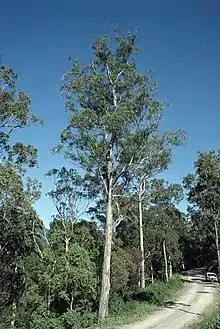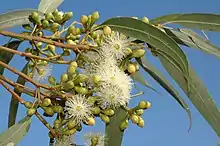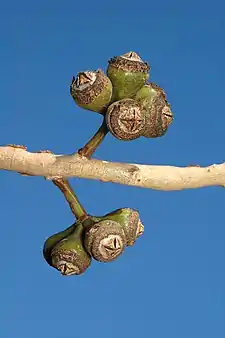| Grey gum | |
|---|---|
 | |
| Scientific classification | |
| Kingdom: | Plantae |
| Clade: | Tracheophytes |
| Clade: | Angiosperms |
| Clade: | Eudicots |
| Clade: | Rosids |
| Order: | Myrtales |
| Family: | Myrtaceae |
| Genus: | Eucalyptus |
| Species: | E. canaliculata |
| Binomial name | |
| Eucalyptus canaliculata | |
| Synonyms[2] | |
| |
Eucalyptus canaliculata, commonly known as grey gum,[3] is a tree endemic to a small area in New South Wales in eastern Australia. It has smooth, mostly grey bark, lance-shaped to curved adult leaves, flower buds in groups of seven, white flowers and conical or hemispherical fruit.


Description
Eucalyptus canaliculata is a tree that typically grows to a height of 30 metres (98 ft) and forms a lignotuber. It has smooth, mainly grey bark with patched of brown or pink and becomes granular with age. Young plants and coppice regrowth have lance-shaped to egg-shaped leaves 60–180 mm (2–7 in) long, 20–50 mm (0.8–2 in) wide, different shades of green on either side, and that always have a petiole. Adult leaves are a darker green on the upper surface, lance-shaped to curved, 80–170 mm (3–7 in) long, 15–50 mm (0.6–2 in) wide on a petiole 15–30 mm (0.6–1 in) long. The flower buds are arranged in groups of seven on a flattened peduncle 13–20 mm (0.5–0.8 in) long, the individual buds on a pedicel 5–8 mm (0.2–0.3 in) long. Mature buds are oval to diamond-shaped, 8–11 mm (0.31–0.43 in) long and 6–7 mm (0.24–0.28 in) wide with a conical to rounded operculum that is narrower than the floral cup. Flowering has been observed in February and the flowers are white. The fruit is a woody, conical or hemispherical capsule, 6–10 mm (0.24–0.39 in) long, 10–15 mm (0.39–0.59 in) wide and larger than other grey gums. The valves of the fruit extend well beyond the rim.[3][4][5]
Taxonomy and naming
Eucalyptus canaliculata was first formally described in 1921 by Joseph Maiden from a specimen near Dungog and the description was published in the Journal and Proceedings of the Royal Society of New South Wales.[6][7] The specific epithet (canaliculatum) is a Latin word meaning "grooved",[8] but the reason Maiden used this name is obscure.[3]
Distribution and habitat
Grey gum usually grows open forest in sites of medium to low fertility such as on dry ridge tops. It occurs in the foothills of coastal ranges near Dungog, Gloucester and Barrington Tops.[3][4][5]
References
- ↑ Fensham, R.; Collingwood, T.; Laffineur, B. (2019). "Eucalyptus canaliculata". IUCN Red List of Threatened Species. 2019: e.T133378387A133378389. doi:10.2305/IUCN.UK.2019-3.RLTS.T133378387A133378389.en. Retrieved 28 September 2021.
- 1 2 "Eucalyptus canaliculata". Australian Plant Census. Retrieved 11 April 2019.
- 1 2 3 4 "Eucalyptus canaliculata Grey gum". Euclid: Centre for Australian National Biodiversity Research. Retrieved 11 April 2019.
- 1 2 Hill, Ken. "Eucalyptus canaliculata". Royal Botanic Garden Sydney. Retrieved 11 April 2019.
- 1 2 Chippendale, George M. "Eucalyptus canaliculata". Australian Biological Resources Study, Department of the Environment and Energy, Canberra. Retrieved 11 April 2019.
- ↑ "Eucalyptus canaliculata". APNI. Retrieved 11 April 2019.
- ↑ Maiden, Joseph (1921). "Notes on Eucalyptus". Journal and Proceedings of the Royal Society of New South Wales. 54: 171–175. Retrieved 11 April 2019.
- ↑ Backer, C.A. (1936). Verklarend woordenboek der wetenschappelijke namen van de in Nederland en Nederlandsch-Indië in het wild groeiende en in tuinen en parken gekweekte varens en hoogere planten (Edition Nicoline van der Sijs).
